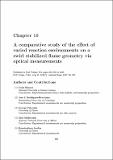A comparative study of the effect of varied reaction environments on a swirl stabilized flame geometry via optical measurements

View/
Date
2018-01-04Author
Banyon, Colin
Rodriguez-Henriquez, Jose J.
Paterakis, George
Malliotakis, Zisis
Souflas, Konstantinos
Keramiotis, Christos
Vourliotakis, George
Mauss, Fabian
Curran, Henry J.
Skevis, George
Koutmos, Panagiotis
Founti, Maria
Metadata
Show full item recordUsage
This item's downloads: 221 (view details)
Cited 3 times in Scopus (view citations)
Recommended Citation
Banyon, Colin, Rodriguez-Henriquez, Jose J., Paterakis, George, Malliotakis, Zisis, Souflas, Konstantinos, Keramiotis, Christos, Vourliotakis, George, Mauss, Fabian, Curran, Henry J., Skevis, George, Koutmos, Panagiotis, Founti, Maria. (2018). A comparative study of the effect of varied reaction environments on a swirl stabilized flame geometry via optical measurements. Fuel, 216, 826-834. doi: 10.1016/j.fuel.2017.09.105
Published Version
Abstract
The present work is a part of a larger experimental campaign which examines the behaviour of various fuels on a swirl stabilized flame burner configuration. Overall, detailed speciation measurements and temperature measurements were combined with optical measurements. The work presented here concerns the part of the experimental campaign which deals with the optical characteristics of the examined flames. The work adds to the growing database of experimental measurements assessing engine-relevant reaction environments which shift from traditional ones in order to meet pollutant emission regulations and efficiency standards. Here, the oxidation of several commonly used fuel and fuel surrogates that are subjected to the addition of a bio-derived fuel additive (dimethyl ether) and emulated exhaust gas recirculation (EGR) is studied in a laboratory-scale swirl stabilized burner. The natural flame chemiluminescence has been exploited to selectively measure line of sight CH* and OH* profiles for combinations of these fuels and reaction environments. As a result, the geometry and intensity of the reaction and oxidation zones have been parametrically evaluated for a sizable number of initial conditions. From an analysis of the collected data, a chemical uniqueness in methane and propane flames has been found along with a change in flame topology as a function reactant temperature and dilution with inert gases, while the flames were virtually unaffected by all other variations in reaction conditions. This insensitivity provides confidence in the use of tailored in-cylinder fluid dynamic/chemical interactions to extend engine operating conditions to otherwise difficult regimes.
Collections
Except where otherwise noted, this item's license is described as Attribution-NonCommercial-NoDerivs 3.0 Ireland
Related items
Showing items related by title, author, creator and subject.
-
Development of correlated and computational methods for predicting premixed turbulent flame speed
Burke, Eoin M. (NUI Galway, 2018-10-02)Turbulent flame speed is an important property within turbulent flames and an invaluable parameter for gas turbine combustor design. A major issue however is the difficulty in accurately predicting turbulent flame speed ... -
Flame inhibition by phosphorus-containing compounds over a range of equivalence ratios
Jayaweera, T.M.; Melius, C.F.; Pitz, W.J.; Westbrook, C.K.; Korobeinichev, O.P.; Shvartsberg, V.M.; Shmakov, A.G.; Rybitskaya, I.V.; Curran, Henry J. (Elsevier BV, 2005-01-01) -
Emission patterns and risk assessment of polybrominated diphenyl ethers and bromophenols in water and sediments from the beijiang river, south china
Xiong, Jukun; Li, Guiying; An, Taicheng; Zhang, Chaosheng; Wei, Chaohai (Elsevier BV, 2016-12-01)

